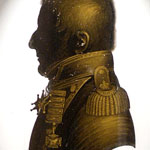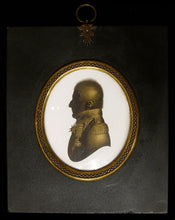Colonel Lord Fitzroy Somerset, Military Secretary to Wellington, 1815
Adding product to your cart
Height of oval 80mm (3 1/8 in) high
Painted shortly after the Battle of Waterloo by John Field (1772-1848) on plaster and bronzed. In period rectangular papier-mache frame. The subject is shown in uniform wearing, the neck badge of the Order of the Bath and Peninsula War Army Gold Cross with five clasps. The reverse with Field’s trade label inscribed 'Colonel Lord FitzRoy Somerset/Nov 1815 K.C.B. K.M.G.'
Lord Fitzroy Somerset, 1st Baron Raglan (1788-1855) was the eighth and youngest son of the 5th Duke of Beaufort. Educated at Westminster School, he entered the army in 1804, and in 1807 was attached to the Hon. Sir Arthur Paget’s embassy to Turkey. The same year he was selected to serve on the staff of Sir Arthur Wellesley in the expedition to Copenhagen. In the following year he accompanied the same general in a like capacity to Portugal, and during the whole of the Peninsular War was at his right hand, first as aide-de-camp and then as military secretary. In 1814 he married Lady Emily Harriet Wellesley-Pole, daughter of the 3rd Earl Mornington, the Duke of Wellington’s niece.
Read more
At Waterloo he was wounded in the right arm and had to undergo amputation, but he quickly learned to write with his left hand, and after the war resumed the duties as secretary to the embassy at Paris. To fit his missing arm his tailor invented a new sleeve with diagonal seam known as the 'Raglan Sleeve'. In 1819 he was appointed secretary to the Duke of Wellington as master-general of the ordnance, and from 1827 till the death of the duke in 1852 was military secretary to him as commander-in-chief, He was the appointed Master-General of the Ordnance, a Privy Counsellor and was created Baron Raglan in 1852.
In 1854 he was promoted to General and appointed to the command of the British troops sent to the Crimea. Lord Raglan and his staff were at the time blamed by the press and the government for the hardships and sufferings of the British soldiers in the terrible Crimean winter before the Siege of Sevastopol. His failure to give coherent or timely commands on the field of battle led to numerous mistakes. Despite this lack of competence on this part, the battle resulted in an Allied victory, and he was promoted to the rank of Field Marshal, before his death the following summer from dysentery.




